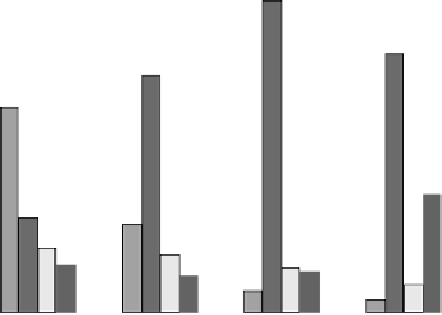Environmental Engineering Reference
In-Depth Information
Oil
Natural gas
Hydropower
Coal
80
70
60
50
40
30
20
10
0
1990
1995
2000
2005
2008
Year
FIGure 17.4 (see color insert)
Fuel mix in electricity generation (1990-2010). (From PTM, National
Energy Balance, 2007, 2009.)
oil industry has grown by leaps and bounds and has emerged as the most remunerative agricultural
commodity, overtaking the position of natural rubber.
In 1960, the total planted area for oil palm was only 55,000 ha. Ten years later, 261,199 ha of land
were cultivated with oil palm. This figure continued to surge—in 1980 to 1,023,306 ha and in 1990 to
1,984,167 ha. In 2008, there were more than 4.48 million ha of oil palm cultivation area in the country.
The oil palm grows well in tropical climates within 5° latitude of the equator (Basiron 1996).
Adequate rainfall of over 2000 mm per year spread evenly throughout the year and adequate
sunshine of over 2000 h per annum with moderately high temperatures of 25-33°C are ideal
growing conditions for the oil palm tree.
The current oil palm planted in Malaysia is known as
Tenera
produced by crossbreeding
Dura
and
Pisifera
. The world production of palm oil in 2008 was 43.1 million tons, 27% of the world
production of 17 oils and fats. Indonesia and Malaysia are the two largest producers, producing
19.3 and 17.7 million tons, respectively, and 86% of the total world palm oil production in 2008
(MPOB 2009a).
The palm tree starts bearing fruit 2.5-3 years after field planting. Harvesting of the oil palm
fruits in bunches is carried out at approximately 30 months after field planting, when the ripeness
of the bunch has reached such that at least some loose fruits drop from the bunch (Pantzaris 2000;
Tang 2009; MPOB 2009b). The usual frequency of a harvesting round is 10-15 days, which is
2-3 times a month. The plant continues to bear fruit for up to 25 years of its economic life and
reaches its optimal yield during its 10th year (Ong et al. 1995). The palm fruit is about the size of
a small plum, weighing, individually, approximately 8-20 g (Wood 1987). It grows large bunches
weighing 10-50 kg, and each bunch consists of up to 2000 fruits (Pantzaris 2000; Tang 2009). Each
fruit contains an exocarp (skin), mesocarp (which contains palm oil and water in a fibrous matrix),
endocarp (shell), and kernel (the seed) (Figure 17.5). The mesocarp contains approximately 49 wt%
palm oil and the kernel contains approximately 50 wt% palm kernel oil.
17.4 Palm BIomass
Palm biomass is obtained under two situations in the field and in the palm oil mill. During the
25 productive years of the palm, the common products available daily are fresh fruit bunches
(FFB) (Figure 17.6) and pruned fronds, whereas trunk together with fronds were obtained during







